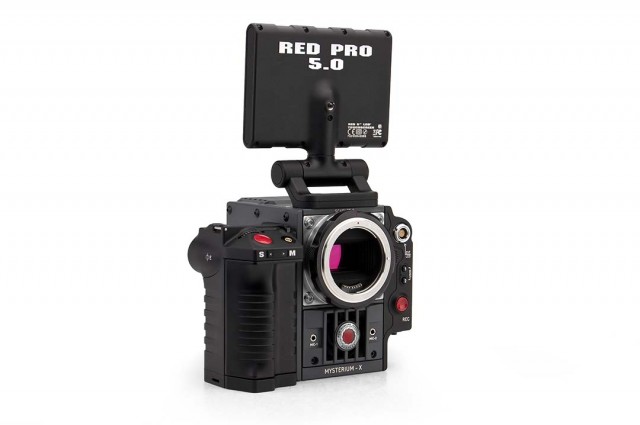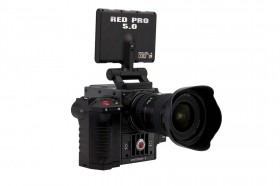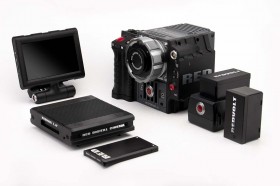 Once upon a time, Scarlet was a camera on the development roadmap of Red Digital Cinema with a 3K 2/3” sensor and a fixed zoom lens. Delivery deadlines were pushed back until this past summer when all news of the camera ceased. Some wondered aloud if the camera would happen at all. Then RED scheduled a delivery announcement for Scarlet on November 3rd, adding what in RED circles has become a familiar idiom, “Oh, by the way, everything’s changed.”
Once upon a time, Scarlet was a camera on the development roadmap of Red Digital Cinema with a 3K 2/3” sensor and a fixed zoom lens. Delivery deadlines were pushed back until this past summer when all news of the camera ceased. Some wondered aloud if the camera would happen at all. Then RED scheduled a delivery announcement for Scarlet on November 3rd, adding what in RED circles has become a familiar idiom, “Oh, by the way, everything’s changed.”
The details of the camera had remained admirably secret leading up to the announcement and a crowd of about 300 gathered at RED Studios Hollywood to find out just what had changed. Jim Jannard, founder of RED, began by saying that as a company they were in the business of making Digital Still and Motion Cameras (DSMC), and that 3K is not good enough for stills. 4K is not enough for stills. That’s why Scarlet-X is a 5K still and 4K motion camera. RED’s 5120 x 2700 5K is close to Canon’s 18 Megapixel 5,184 x 3,456 APS-C 7D and Nikon’s 16.2 Megapixel 4,928 x 3,264 APS-C D7000. (The higher overall Megapixel specs for the Canon and Nikon take into account the taller APS-C image: APS-C aspect ratio is 3:2)
Some had speculated that Scarlet would be a de-caffeinated version of the EPIC, and that’s exactly what it is. “She is EPIC’s little sister,” said Jannard. Scarlet will share all the accessories of the EPIC, including interchangeable lens mounts. It records REDCODE RAW to the same SSD drives and the files work seamlessly with REDCINE-X Professional, RED’s processing and grading software. Even the sensor is the same Super 35-sized MYSTERIUM-X sensor used in RED’s other cameras.
So what’s the difference between Scarlet and EPIC? In short, data rate. Scarlet has a significantly slower data rate than EPIC. While still an impressive 50 MB/s (440Mb/s), it does limit the available frame rates at various resolutions:
- up to 12 fps at 5K (think “motor-drive” stills)
- 1-25 fps at 4K (4096 x 2160)
- 1-48 fps at 3K
- 1-60 fps at 2K
- 1-120 fps at 1K
For HDR-X frame rates, divide by 2. In highlighting the divide further Jannard said, “If someone with an EPIC has been shooting 4K at 96 fps they’re not going to want to give that up.”
While the data rate serves to differentiate the two cameras, it also factors into the price of the Scarlet. When making the EPIC, a lot of the ASIC chips were not fast enough for the EPIC’s data rate needs and were put on a shelf. These chips are now being repurposed in the less-demanding Scarlet, decreasing manufacturing costs.
The Scarlet-X will be be released in two basic packages, with a choice of PL or Canon mounts. Other mounts will surely follow (Leica M, etc.) The mounts are available in titanium for PL and Canon or aluminum for Canon. (Titanium is stronger and does not readily expand or contract in extreme temperatures.)
- Scarlet-X Brain
- Side SSD Module
- Canon EF Mount
- Scarlet-X Brain
- Side SSD Module
- PL Mount
In the lengthy Q&A following the announcement, Jannard covered a few more points of interest.
- The Canon EF mount, made by RED, supports auto-focus.
- The MYSTERIUM-X sensor will be upgradeable to RED’s Dragon sensor (currently in development), although it will require some internal boards to be replaced.
- Scarlet has all the 3D capabilities and functionality of the EPIC.
- Still photos will use the full 5K sensor (5120 x 2700, nearly 14 megapixels).
By making SCARLET a 4K camera, RED keeps the family together; it joins RED ONE and EPIC.










